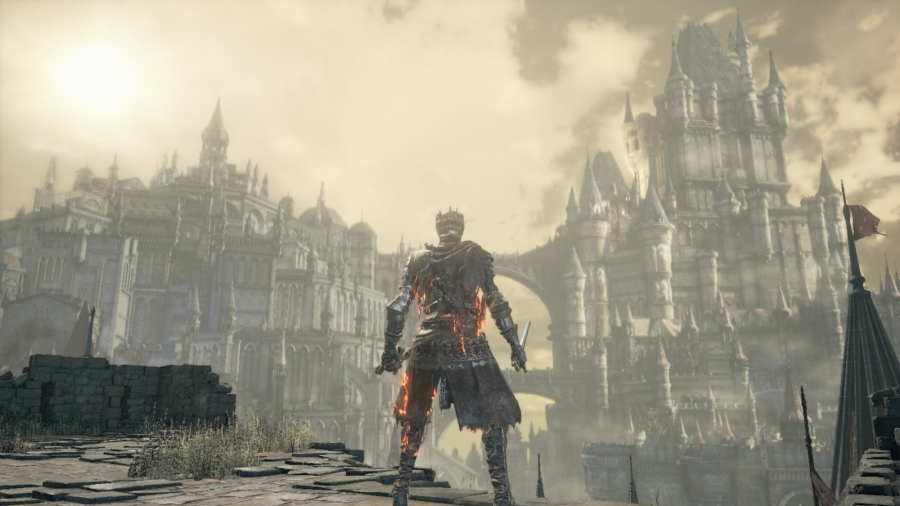Review: Dark Souls 3 is a triumph of classic video game adventure
The view from the High Wall of Lothric, one of the first vistas in the game preparing players for the scale of this new adventure. Photo credit: Leslie Kivett
April 12, 2016
Past tattered banners and crumbling cobblestone columns, steeped in rotting tree roots and cobwebs, cracked wooden and sun-lit doors open to castle battlements so high and the vision of a fortress so grand and imposing that there can be no other thought in mind than the excitement, potential, brilliance and pitfalls of the adventure about to unfold.
This scene, beautifully realized by the intensely talented artists at developer From Software, is one of the very first sights players who embark into the perils of Lothric in “Dark Souls 3” will see.
This third entry in the now profaned franchise captures a spirit of adventure like no entry in the series has. From the reeking and noxious forest of Farron to the mysterious and Victorian-esque city of Irithyll, there is no corner of “Dark Souls 3” that isn’t wrought with opportunities for exploration.
Help or direct instruction is almost nowhere to be found in the game. This is a game of subtlety that uses mechanics like level design, enemy placement and even the landscape itself to lure players into both glory and peril.
Experienced and grizzled veterans of the franchise will know the stakes: A kingdom once opulent and grandiloquent now fallen to ashes and cinders awaits brave warriors after the engulfing wave of the Undead Curse, a sickness that sweeps across all of humanity, disabling the afflicted from dying and slowly draining their sanity and purpose away with each passing day that has debilitated the land to a state of ruin.
The new setting “Dark Souls 3” offers is no different in this regard of faded glory. However, the way players will be experiencing these areas has changed. Where previous entries have had areas impressive in both complexity and scale, It puts them to shame with a cast of locations as complex as they are intimidating. The extent of paths, shortcuts, and methods of reaching an area’s end have taken a shift for the dynamic. No longer are environments characterized by only a singular path forward laden with traps and cleverly placed enemies.
Now, an observant or diligent player will find many ways of making it through to the other side of a level, create shortcuts to specific locations and even find masterfully hidden areas, each encumbered with its own devious offering of challenge and treachery.
This shift to more complex level design not only contributes to the sense of adventure I believe characterizes “Dark Souls 3,” but in combination with the exquisite subtlety of its conveyance and story telling, the world feels more alive, more like it’s fighting to keep players out of its reaches and away from its secrets.
Joining the level design in a revamped take is a course of bosses more dynamic than most action/adventure games have been able to offer before. The Dark Souls franchise has always held true to an action-oriented framework for its major encounters, shying away from the more puzzle-based fights like those in “The Legend of Zelda” or the heavily scripted, predictable encounters seen in high-budget, set-piece focused games. The same is true here, and “Dark Souls 3” stands out, both furthering this principle and incorporating new ideas that challenge players beyond knowing simply when to dodge and strike.
Every boss integrates changes in tactics and can employ clever counters to common player maneuvers. The all-too-famous strategy of circle strafing is a huge target of this, as it is consistently countered or negated by enemies throughout the game. When bosses take a certain amount of damage, they’ll begin to change their methods and incorporate new attacks and aspects of their environment as well, marked perfectly by a dramatic shift of soundtrack to really drive home the change and continuing to force players to learn through multiple layers of an encounter.
Many players who adore the Dark Souls franchise for its unrelenting challenge of player skill may find these bosses that incorporate a puzzle or trick to be dissatisfying, as once players know the solution some of these bosses won’t pose a challenge again. But I believe this change, which is only present in some fights and by no means replaces the famed “Dark Souls” framework, adds a special twist of variety and a spark of nature to the game, for both gameplay and storytelling reasons.
Running on Xbox One, the game for the most part keeps on pace for a consistent 30 frames per second. However, some more demanding or highly populated areas chug down closer to 20-25 in small stretches. Players of the original “Dark Souls” release will find a similar level of performance throughout the game, with some areas and bosses simply being more prone to slowdown and reduced frame rate than others.
Publisher Bandai Namco has stated that the early versions have not been optimized and will be with the application of a Day 1 patch arriving on April 12, the official release day of the game. It is unknown how that patch will truly affect the technical performance of the game, but by no means is “Dark Souls 3” troubling to play even in its review build.
What From Software has done with its third outing of their beloved franchise is both daring and traditional. The themes of deterioration and decline, the beautifully realized and detailed environments, the subtle storytelling and carefully hidden secrets, the mounting challenge and strange atmosphere, and basically everything about “Dark Souls” has been amplified and improved by an engine and generation of hardware capable of bringing to life the dynamic world From Software has always aspired for.
Dark Souls 3 is a triumph of classic video game adventure, strictly testing the abilities and determination of its players. To anyone who appreciates the potential and beauty of game design, is looking for an enthralling atmosphere and detailed lore or simply wants to test their mettle against the demanding challenges it has to offer, I implore you to take the plunge into Dark Souls 3.






